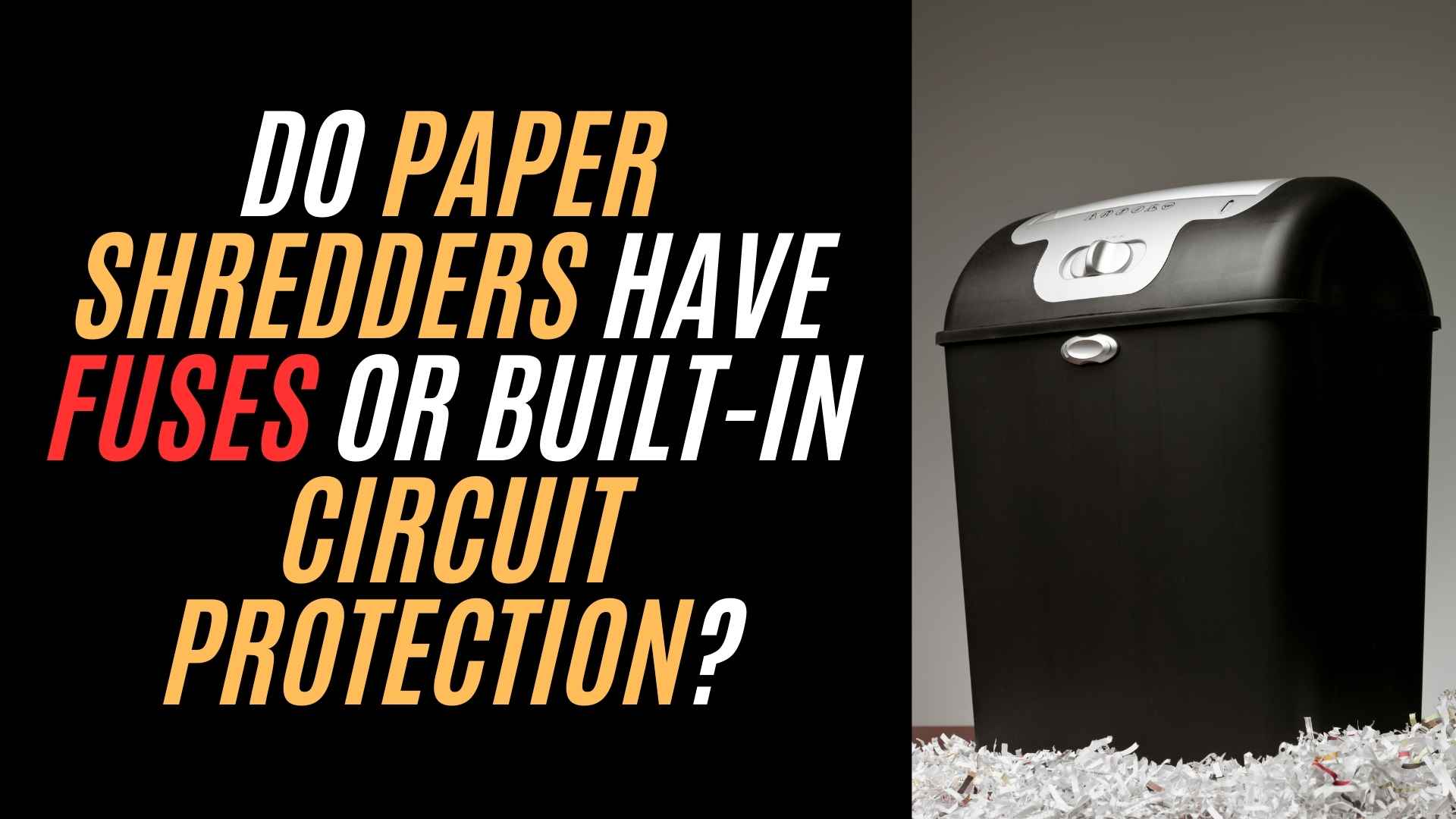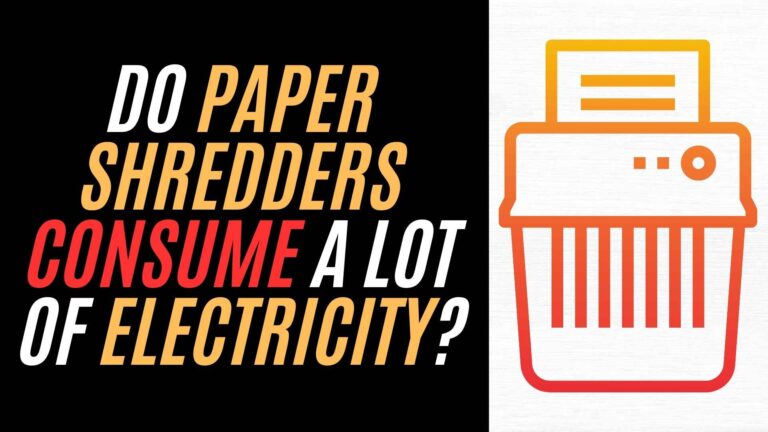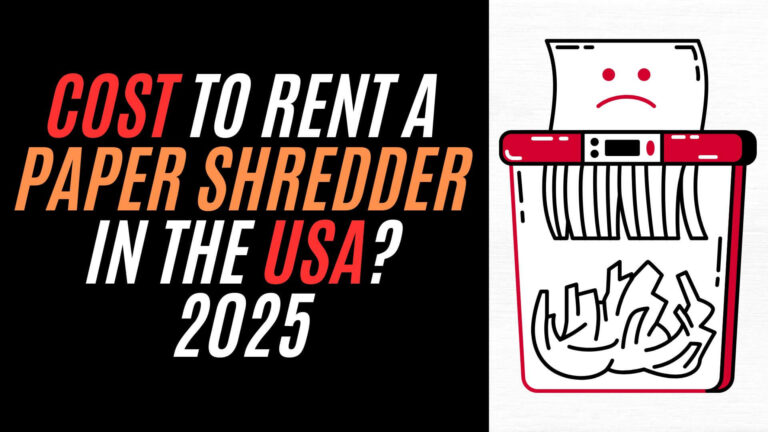Paper shredders are essential tools in both homes and offices, ensuring that sensitive information is disposed of securely. From personal documents to business files, shredders help maintain privacy and safeguard against identity theft. While these machines are built with various safety features to enhance security and efficiency, one common question often arises: Do paper shredders have fuses?
It’s a concern that many users have when their shredder malfunctions or overheats. In this post, we’ll explore how shredders are designed to protect themselves from electrical damage, and whether fuses are part of that protection.
Understanding the Role of a Fuse in Electrical Devices
A fuse is a small but crucial component in many electrical devices, including paper shredders. It serves a protective function by preventing electrical overloads that could otherwise damage the internal components of the appliance. Fuses are designed to “blow” or break the electrical circuit when too much current passes through them. This helps prevent overheating, fires, or further damage to the device’s motor.
In the case of paper shredders, the fuse is typically part of a broader circuit protection system designed to shield the machine from electrical failures. Most modern shredders have built-in safety mechanisms that work together to ensure the longevity of the device.
Fuses are often used in tandem with thermal protection systems or circuit breakers, all of which are essential in preventing overheating and other electrical faults. These mechanisms help to safeguard the motor and internal circuitry, ensuring the shredder continues to function safely without any risk of electrical malfunction.

Do Paper Shredders Have Fuses?
When it comes to the specific question of whether paper shredders have fuses, the answer is: it depends on the model. Some shredders are equipped with fuses, which protect the motor from excessive electrical current, while others rely on different forms of circuit protection. For instance, many shredders use thermal overload protection, which automatically shuts off the motor when it gets too hot.
In addition, higher-end shredders, especially those designed for heavy-duty use, often come with circuit breakers instead of fuses. Circuit breakers offer a more reliable, reusable option for circuit protection. When the shredder detects an electrical fault or overload, the circuit breaker trips and can be reset once the issue is resolved. Fuses, on the other hand, need to be replaced once they blow.
While both systems—fuses and circuit breakers—serve similar protective functions, the main goal is to prevent the motor from burning out or the machine from overheating due to power surges or prolonged use.
Types of Circuit Protection Found in Paper Shredders
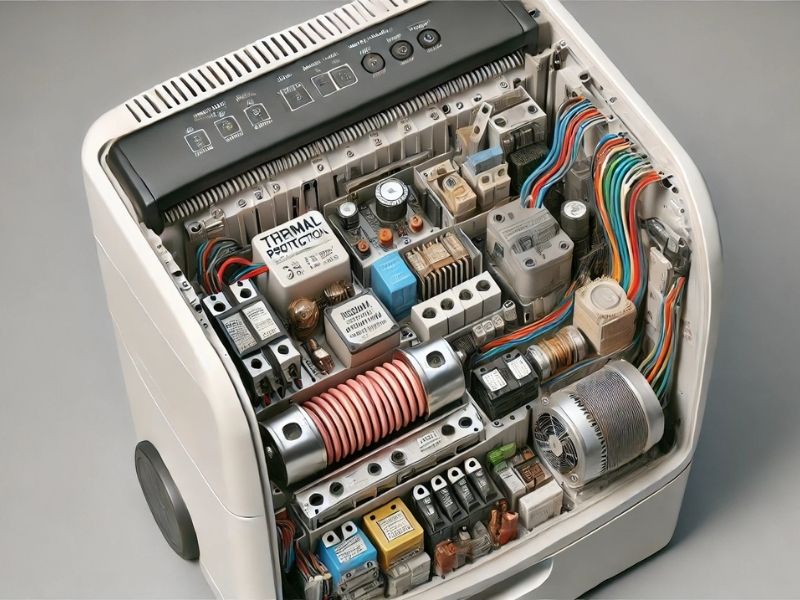
Fuses:
Fuses in paper shredders act as a fail-safe. When the machine experiences an electrical overload or a short circuit, the fuse breaks the circuit to stop the current flow, protecting the motor and other critical components from damage. These fuses are usually located near the power supply and can often be accessed and replaced by the user.
Pros of fuses:
- Easy to replace: If a fuse blows, it’s generally a quick fix.
- Inexpensive: Fuses are cost-effective protection options.
Cons of fuses:
- One-time use: Once the fuse blows, it needs to be replaced. If you don’t have a spare fuse, this could cause temporary disruption until it’s fixed.
Thermal Protection:
Many modern shredders are equipped with thermal overload protection. This system monitors the temperature of the motor and automatically shuts off the shredder when it becomes too hot. This is especially useful for preventing overheating during heavy use. When the shredder cools down, the motor will restart, and the machine can resume normal operation.
Pros of thermal protection:
- Prevents overheating: Ensures the motor doesn’t burn out from excessive heat.
- Automatically resets: No need to manually reset the system once it cools down.
Cons of thermal protection:
- Limited usage duration: Some shredders can only run for a set period before needing to cool down. This might be inconvenient for larger shredding tasks.
Circuit Breakers:
Some shredders are equipped with circuit breakers, which act like fuses but are reusable. When an overload occurs, the circuit breaker trips, cutting off the electrical flow. Unlike fuses, circuit breakers can be manually reset once the issue is resolved.
Pros of circuit breakers:
- Reusable: Once tripped, you can simply reset the breaker and continue shredding.
- Better for long-term use: They are more durable, making them ideal for heavy-duty shredders.
Cons of circuit breakers:
- More expensive: Circuit breakers can increase the overall cost of the shredder.
- Can be complex: Users may not always know how to reset them, requiring a bit of troubleshooting.
How to Check if Your Paper Shredder Has a Fuse or Protection

When your paper shredder stops working, one of the first things to check is whether the fuse or protection system has been triggered. Here’s a step-by-step guide on how to inspect your shredder:
- Unplug the Shredder: Safety first! Always disconnect the shredder from the power source before inspecting.
- Locate the Fuse or Protection System:
- For Fuses: If your shredder uses a fuse, it will usually be found near the power cord or under a panel on the back or bottom of the unit. Some models may have an easily accessible compartment that you can open to check the fuse.
- For Thermal Protection or Circuit Breakers: Many modern shredders use thermal protection or circuit breakers instead of fuses. These may not be as visible but could be located near the motor or inside the shredder housing.
- Look for Signs of a Blown Fuse: A blown fuse often shows signs of damage or discoloration. If the fuse appears intact but the shredder still doesn’t work, the issue might be elsewhere, such as overheating or a motor failure.
- Check for Activation of Thermal Protection: If your shredder has overheated, the thermal protection will automatically shut it down. In this case, allow the shredder to cool down for a while (usually 20-30 minutes). If the shredder still doesn’t work, you may need to reset or replace the protection system.
- Common Warning Signs: If your shredder stops suddenly or doesn’t start at all after use, it may indicate that the fuse or protection has been triggered. Additionally, if the shredder feels unusually hot or emits strange smells, it could be overheating.
By checking these components, you can often diagnose simple issues and get your shredder running again. If you’re unsure, refer to the manufacturer’s manual for precise details on where to find the fuse or reset features.
Common Issues with Paper Shredders and Circuit Protection
Paper shredders are essential tools for maintaining privacy and security, but like all machines, they can encounter problems. Here are some common issues, along with how circuit protection systems play a role:
1. Paper Jams:
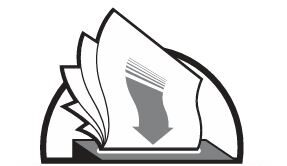
- Cause: Overloading the shredder with too many sheets of paper, improper feeding, or using the wrong type of paper.
- Role of Protection: Many shredders have a circuit protection system that detects jams. If a jam is detected, the shredder will stop working to prevent further damage to the motor. In some cases, the fuse may blow or the thermal protection will engage to prevent overheating.
2. Overheating:
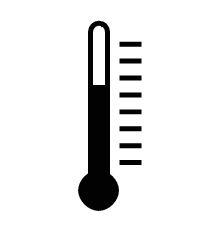
- Cause: Prolonged use without breaks or excessive paper being fed through at once.
- Role of Protection: Thermal protection systems automatically shut off the shredder when it overheats, allowing it to cool down and avoid damage. This is especially useful if the shredder is used for extended periods or in environments where ventilation is poor.
- What Happens: If overheating occurs, the shredder may not start until the temperature has dropped to a safe level. This is why some shredders have a cool-down period before they can be used again.
3. Motor Failure:
- Cause: Overuse or long-term wear can cause the motor to fail.
- Role of Protection: Fuses or circuit breakers can help prevent complete motor failure. If the motor is under strain due to a jam or overload, the fuse may blow to prevent further damage. For shredders with a circuit breaker, simply resetting the breaker can resolve the issue.
4. Troubleshooting:
- If the shredder stops working, first check for a blown fuse or an activated thermal protection system. For paper jams, use the reverse function to clear the blockage and reset the shredder.
- Important Tip: Always make sure the shredder is cool and clean, as dirt or paper debris can trigger overheating. Regular maintenance helps ensure these protection systems work effectively.
How to Replace a Fuse in a Paper Shredder (If Applicable)
If your paper shredder uses a fuse and it’s blown, don’t worry—it’s usually a quick fix!
Here’s a step-by-step guide to replacing a fuse in your shredder:
- Unplug the Shredder: Always disconnect the shredder from the power outlet before working on it to avoid electrical hazards.
- Locate the Fuse: Check the user manual to find the exact location of the fuse. Fuses are typically located near the power cord, under the shredder’s bottom or back panel. Some shredders have a dedicated fuse compartment that can be easily opened.
- Remove the Old Fuse: Use a small screwdriver or your fingers to remove the blown fuse. You may need to gently pry open a compartment or lift a panel to access it.
- Get a Replacement Fuse: Make sure you purchase a fuse that matches the specifications listed in the user manual. Using the wrong type or size could cause further damage to the shredder.
- Insert the New Fuse: Carefully insert the new fuse in the correct position. Ensure it fits snugly and is properly aligned.
- Test the Shredder: After replacing the fuse, plug the shredder back in and test it to ensure it’s working. If the shredder still doesn’t work, the issue may lie with the motor or thermal protection system instead.
What if Your Shredder Doesn’t Have a Fuse?
For models equipped with thermal protection or circuit breakers, the process is slightly different. Simply check if the protection system has been triggered. If it’s a circuit breaker, reset it by flipping the switch back to its original position. For thermal protection, allow the shredder to cool for a period (usually 20-30 minutes).
Regular maintenance and correct usage can prolong the life of your shredder and prevent fuse-related issues.

Is It Better to Have a Fuse or Other Protection Systems?
When choosing a paper shredder, it’s important to consider the type of protection system it uses. Let’s compare the advantages and disadvantages of fuses versus other types of protection like thermal overload protection and circuit breakers:
Fuses:
- Pros: Simple, cost-effective, and easy to replace. A blown fuse is a clear sign of an overload, making it easy to diagnose.
- Cons: Requires manual replacement. If the fuse blows repeatedly, it could indicate an underlying issue with the shredder that needs addressing.
Thermal Protection:
- Pros: Automatically shuts the shredder off when it overheats, protecting the motor without user intervention. Ideal for long-term use.
- Cons: Cannot be reset immediately—usually requires a cooling down period before the shredder can be used again.
Circuit Breakers:
- Pros: Like thermal protection, circuit breakers automatically shut off the shredder when an overload occurs. They are also easily reset, meaning you don’t have to wait for cool-down periods.
- Cons: Some users may find resetting the breaker inconvenient, especially if it frequently trips due to frequent jams or overuse.
Which System is Better?
While all three systems serve their purpose, the best choice depends on your shredder usage. For those who shred frequently, thermal protection or circuit breakers may offer more convenience, as they don’t require manual intervention. However, if you want simplicity and easy replacement, fuses might be the right option.
Ultimately, most consumers prefer shredders with both thermal protection and circuit breakers for comprehensive protection.
Tips for Maintaining Your Paper Shredder to Prevent Fuse Issues
Maintaining your paper shredder is key to preventing fuse issues and prolonging the life of your machine. Here are some straightforward steps to keep things running smoothly:
- Avoid Overuse: Most shredders aren’t designed for continuous operation. Give your shredder some rest between uses to prevent overheating. Running it for long periods without a break can stress both the motor and the fuse.
- Keep It Clean: Regularly empty the shredder bin and clean any debris out from the blades. Over time, paper dust can clog the machine, leading to overheating. Use compressed air or a soft brush to clear out hard-to-reach areas.
- Lubricate Your Shredder: Apply shredder oil to the blades to ensure smooth operation. Oiling the blades regularly helps prevent jams and reduces friction, which can cause overheating and damage.
- Use Within Capacity: Always check your shredder’s recommended sheet capacity and avoid overloading it. Overloading strains the motor and can trip the circuit protection system.
- Allow Cool-Down Time: If you’re using your shredder for an extended period, allow it to cool down to avoid triggering the thermal protection. This helps protect the fuse and ensures the motor doesn’t overheat.
Conclusion
In conclusion, understanding the role of fuses and circuit protection in your paper shredder is essential for both safety and longevity. Regular maintenance, such as cleaning, lubricating, and allowing the shredder to cool down, can prevent common issues like overheating and blown fuses.
By ensuring that your shredder operates within its limits and maintaining its internal components, you can avoid unnecessary damage and enjoy a longer lifespan for your device. Make it a habit to check your shredder for these protective features, and you’ll save time, money, and frustration in the long run.
FAQs
Why is my shredder not turning on after overheating?
If your shredder doesn’t power on after overheating, it’s likely that the thermal protection has been triggered. Most shredders have an automatic shut-off to prevent damage from excessive heat. To fix this, simply unplug the shredder and let it cool down for at least 30 minutes before trying again. If it still won’t start, check the fuse or reset button, depending on your shredder’s design.
How can I tell if my shredder needs a new fuse?
If your shredder is not turning on and you’ve already checked for overheating or jams, it may need a new fuse. If the fuse has blown, it typically won’t allow power to flow through the machine. Consult your user manual for the location of the fuse and check for any visible signs of damage, such as discoloration or burns. If you’re unsure, replacing the fuse is often a quick and inexpensive fix.
Can I use my shredder without a fuse?
Using a shredder without a fuse is not recommended, as the fuse is a critical safety feature. It prevents overheating and protects the motor and electrical components from damage. If your shredder does not have a fuse, ensure that it has some other form of protection, such as thermal protection or a circuit breaker. Operating without any safety features can risk damaging the shredder or causing electrical hazards
